Disclosure: Please note that some links are affiliate links, and at no additional cost to you, we earn a commission if you make a purchase.
If you would like to support this website in some way, using these links will help do exactly that.
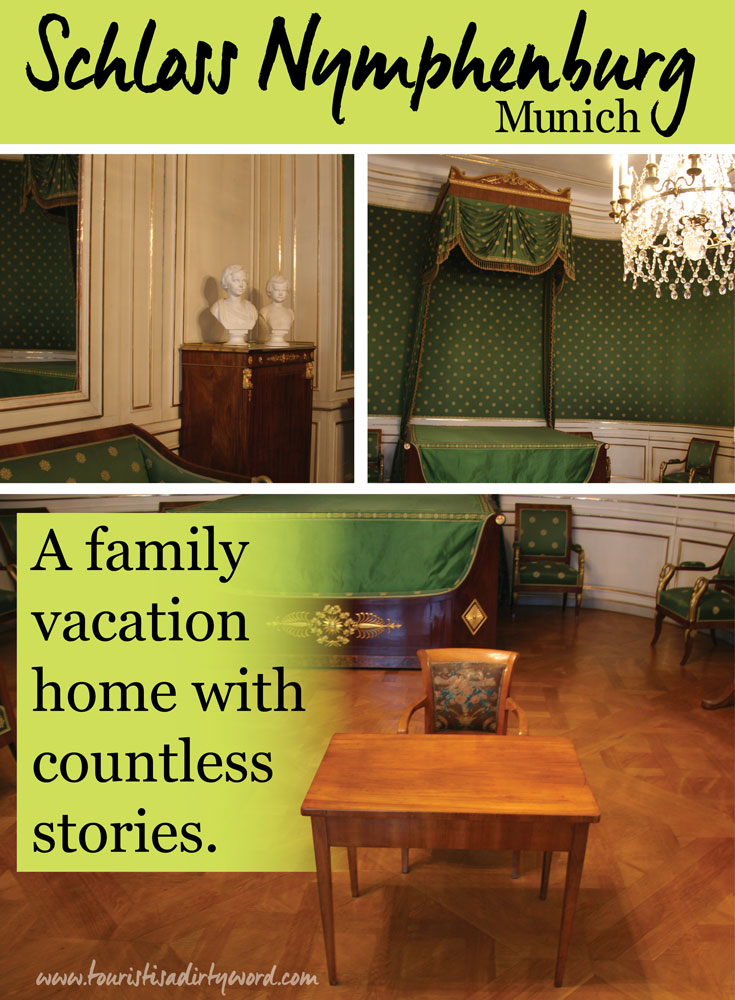
Seeing the tiny, child-size chair and kid's table in the Queen’s room made the palace feel like a home rather than an ongoing museum. That chair and table was once King Ludwig II’s when he was a child. Generation after generation, ultimately this palace, Schloss Nymphenburg, is a family vacation home with many stories to tell.
It was a Sunday morning during Oktoberfest, and we chose to visit Schloss Nymphenburg out of a dizzying array of choices because it felt like it had a little bit of everything; art, history, architecture, and gardens. We had the entire morning to visit the palace and gardens, but to see everything including the pavilion interiors and not be rushed, allow for a full day.
The Great Hall
We entered the Palace through the Great Hall, and the sight of the vaulted ceiling and accompanying gold-gilded stucco work simply took my breath away. When I see such historic, beautiful architecture still existing in person, my eyes tend to water with joy. Yep. I’m that girl, getting all misty-eyed looking at art.
The ceiling was huge, technically two stories since on one side there was a staircase that went up a level to also overlook the hall. I looked at Sebastian, and he knew what was about to happen. I needed to stare at this ceiling, agog in wonder, for a healthy 10 minutes, and take fifty photos or so of various angles before moving on. The stunning ceiling fresco was the work of Johann Baptist Zimmermann, his son Franz Michael, and Martin Heigl between 1755-1757 under Max III Joseph’s rule. The Great Hall has remarkably remained unchanged and preserved as an authentic Rococo room since 1758.

Ten Minutes Later...
We start our way through the wings of the castle, and its immediately ‘choose your own adventure’ as rooms broke off into other rooms and we weren’t sure if we’d end up missing something by accident or going around in circles.
One thing that stood out to me was how often paintings of the palace itself showed up in frames on the wall. It was as if the palace was a family pet that had numerous photos of its antics over the years. The truth is, they needed to constantly paint the palace in order to remember what it looked like. Every generation left their mark on the palace and its design. Many of the furnishings were original or of the time of the palace, often filled with portraits of previous homeowners looking back at you while you’re looking at their belongings and collections.
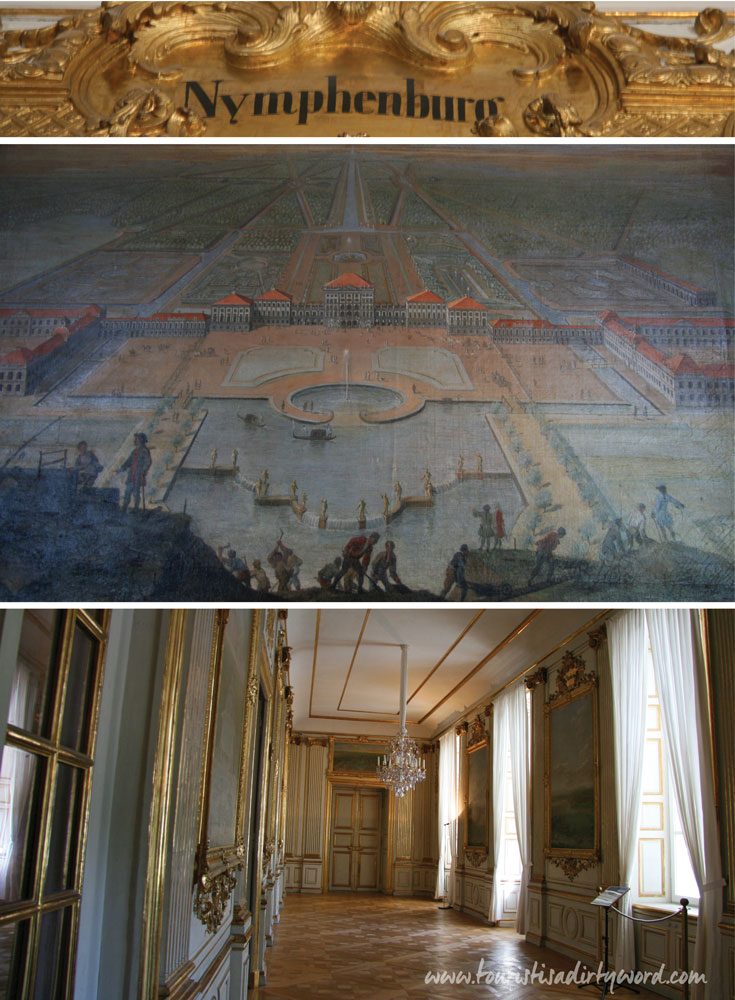

King Ludwig I Gallery of Beauties
When I asked Sebastian what stood out in his memory of the palace, he immediately said the Gallery of Beauties. In the dining room of the Queen’s apartment, the Gallery of Beauties is displayed, a collection of 35 paintings by Joseph Stielier as a commission of King Ludwig I. They were all beautiful ladies, but from all different walks of life, and not necessarily German. The ladies’ wit, personality, and virtue must also be ideal to be included.
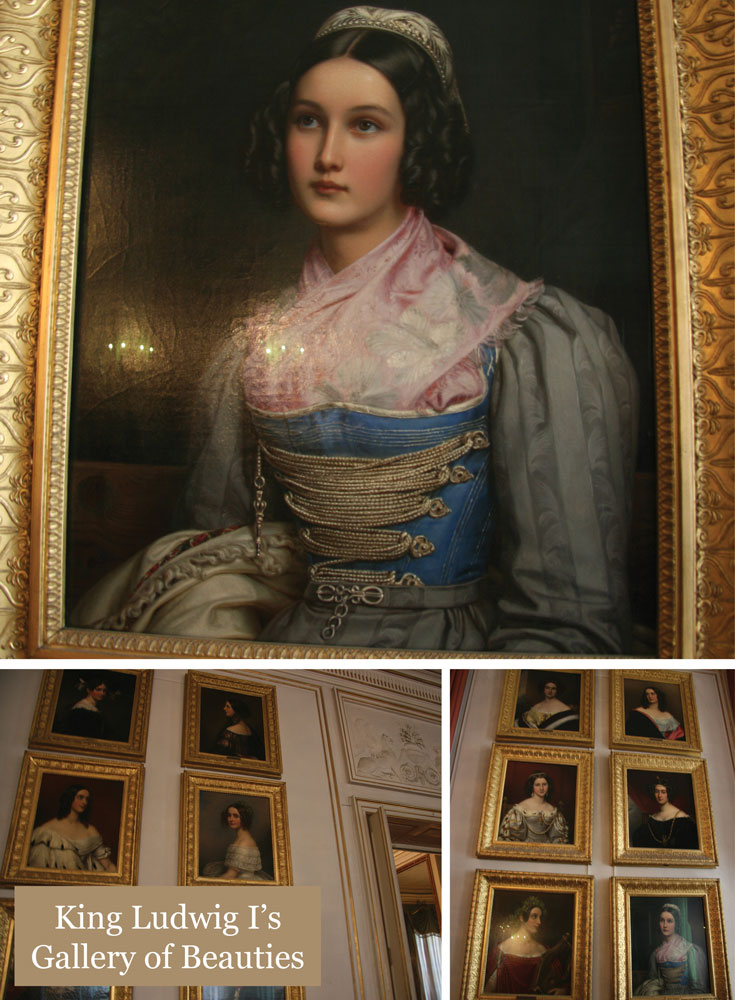
King Ludwig was wholly involved in the project, and out of fourteen ladies nominated by the artist, the King would choose one. His step-mother nominated Elise List, and his wife Therese nominated and convinced Miss Erskine to be a part of the collection. The king would be present during the portrait sittings with Stielier and even direct the outfits. He hand selected and purchased the traditional Bavarian costume for the master shoemaker’s daughter Helene Sedelmayer. Ultimately his friendship with one of his ‘beauties’ would result in his abdication from the throne. If this is interesting for you, I have the perfect book recommendation: King Ludwig I's Gallery of beauties (affiliate link)
It took us several hours to visit all of the accessible rooms in the palace. After concluding our palace visit, we took a leisurely stroll through the park.
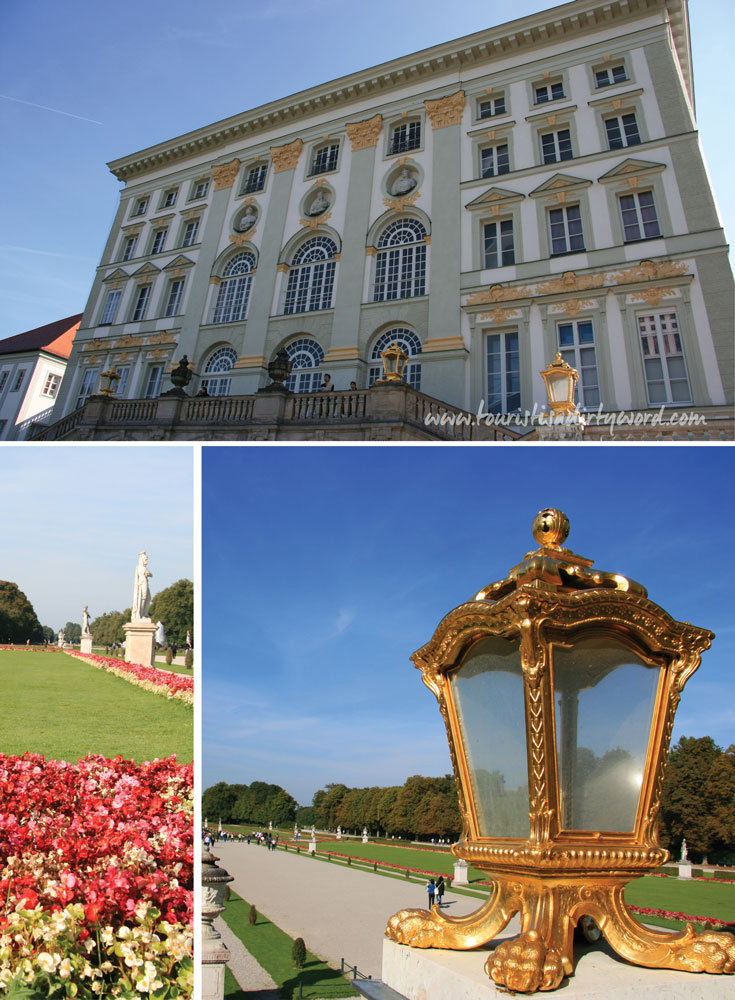
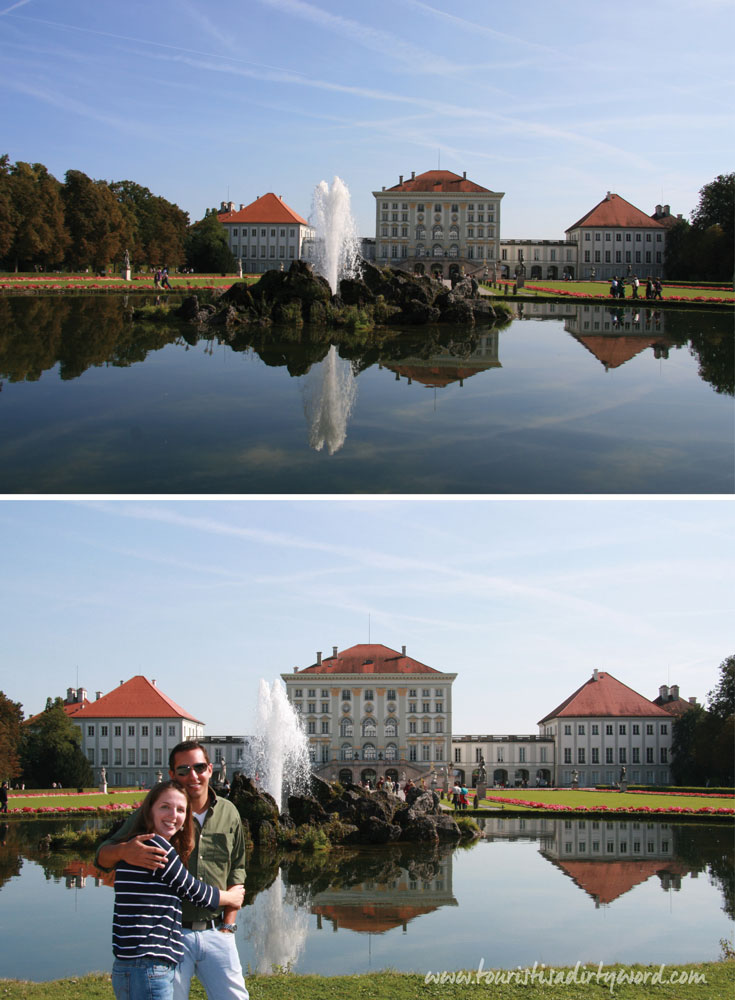
Park Pavilions
Schloss Nymphenburg was the ‘I want to get away from it all’ recluse for the ruler of Bavaria. It was a 2-hour carriage ride from the Munich residence. When you want to escape, reflect, or relax, you’ll need gardens, baths, and sports to unwind with. Over time, the palace grounds provided all of that through numerous pavilions; Amalienburg hunting lodge, the Badenburg bath house, Magdalenenklause for spiritual solace, and Pagodenburg for resting between outdoor games. You’ll need a combination ticket to get inside the pavilions, but to see the outside of them it's part of the public park. We knew we wouldn’t have time to visit inside, but we still wanted to visit the grounds and get an idea how big the park was.
Well, it turns out it's pretty big, and we got lost! Ha! We were trying to hunt down the Monopteros by the lake, and our direct path in our minds turned out to be very roundabout way. We found the Little Village with ‘Green Pump House’ way before we found the picturesque Monopteros. Wear something you can walk comfortably on gravel paths. To explore all of the pavilions you’ll have to walk! To rest up, we had a light lunch Café im Palmenhaus alongside the park before hitting the gift shop for art books on our way out.

Souvenir Recommendations
I chose and whole-heartedly recommend these two:
1. Nymphenburg Palace, Park and Pavilions - Bayerische Schlösserverwaltung. Small but swarthy overview of the building history and room by room descriptions of the objects in each room, including the paintings.
2.King Ludwig I's Gallery of beauties (affiliate link) by Gerhard Hojer which reproduced all 36, including the 1 lost portrait painting, with several essays as well as biographies of each of the ladies. I knew it would have all the details I needed and didn’t have time to read in the exhibit. This book may be best served buying in advance of your trip and reading before you go. The biographies on the ladies’ alone are fascinating.
Follow Along
If you enjoyed this article, or these topics sound interesting to you, you'll love our weekly newsletter. You'll receive a free Germany Packing list for signing up, and you'll receive each week's newest posts every Friday. Thank you for reading!

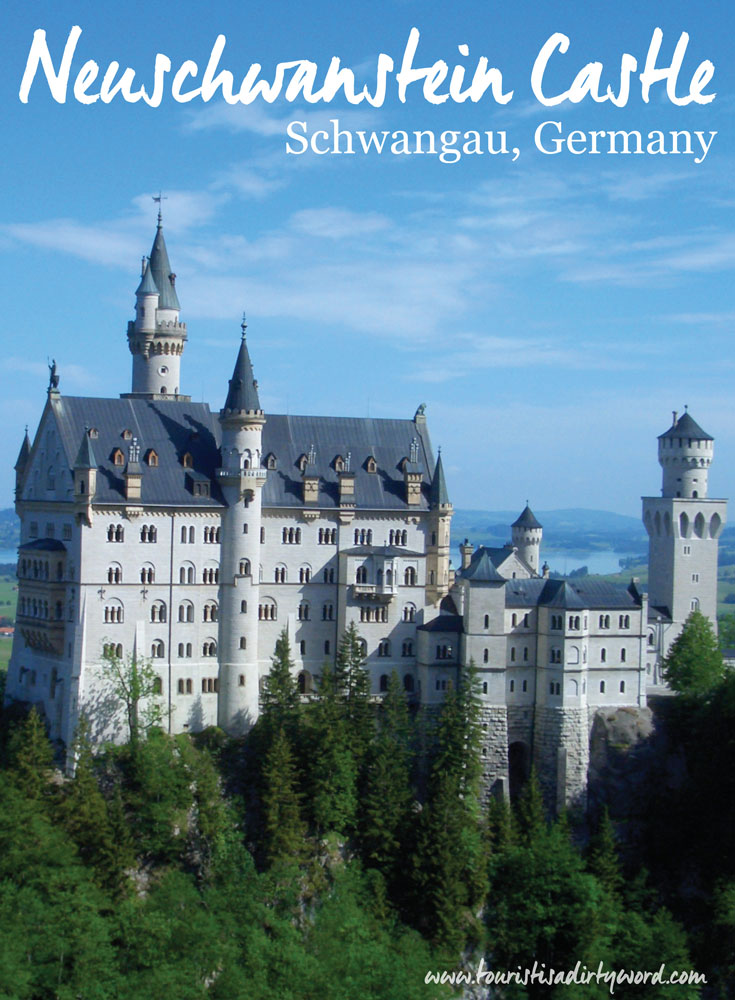
“If you get up early, you will have more of the day,” he’d tell me. My grandpa, lovingly called Opa, was always on my case when I slept in until noon during my teenage years. I gave him, at best, a weary smile.
When we planned a family visit to Neuschwanstein Castle, Opa exhorted us to leave early, right after sunrise. My navigation app forecasted about 4 hours of driving, which Opa would cut to a little over 3 hours. He has a heavy right foot. I did not know it yet, but this time I was relieved that I listened and got up as early as I did.
Construction and Tragedy
Neuschwanstein Castle (Schloss Neuschwanstein) in southern Bavaria is without a doubt the most visited German castle with more than one million visitors every year. The castle was built for King Ludwig II on a rugged hill within a short walking distance from nearby Hohenschwangau castle, the summer residence of the royal family. Construction started on September 5, 1869 and was mostly finished 17 years later in 1886. King Ludwig II moved into his castle for the first time in 1884, where he only spent eleven nights from May 27 until June 08 before drowning on June 13. To this day it is unclear if his death was suicide, an accident, or murder.
Inspiring Walt Disney
One of the biggest ironies of Neuschwanstein is that the castle was built to be a private refuge on a high hill, but now hosts up to 6,000 tourists per day. The unique and breathtaking location paired with the sheer size of the castle, makes for a fantastic, magical sight. Even Walt Disney could not resist and used Neuschwanstein as inspiration for his Cinderella castle at his theme parks.
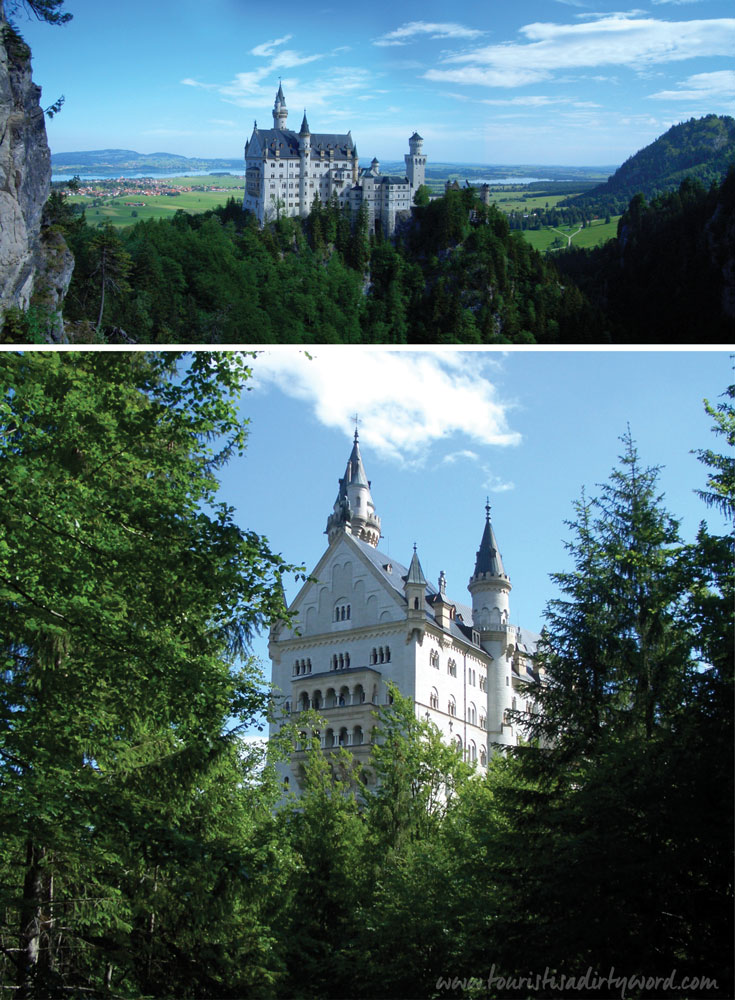
Getting the Postcard Photo
I still remember the cool and partly foggy morning when we arrived at the foot of the castle and my Opa walked up to the will-call counter and returned only a couple of minutes later smiling with tickets for all of us in his hand. I think he enjoyed the fact that he had been to the castle before and could be our tour guide.
And a great tour guide he was, leading us up the hill onto the Marienbrücke (Queen Mary's Bridge). This bridge is THE viewing platform with a great view of Neuschwanstein and I highly recommend not to miss the view from there. Here is a picture of us on the Marienbrücke, but a picture does not do the view justice. Underneath your feet you will hear a waterfall crashing down the rock walls into a gorge, making it quite “an experience” for someone who is afraid of heights, like me.
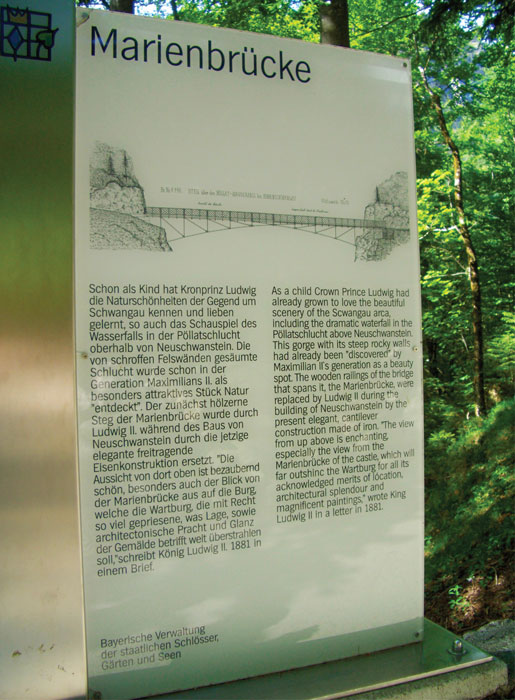
The Marienbrücke is currently closed until Summer 2016. If you still want a great picture and don’t mind a little adventure hiking into unmarked territory, check out this blog post from Justin Goes Places.
After we enjoyed the view and exhausted all of our photo ideas from the Marienbrücke, we wandered up to Neuschwanstein Castle and waited about 10 minutes in a courtyard crowded with others waiting for their entrance time to show up on a digital screen.
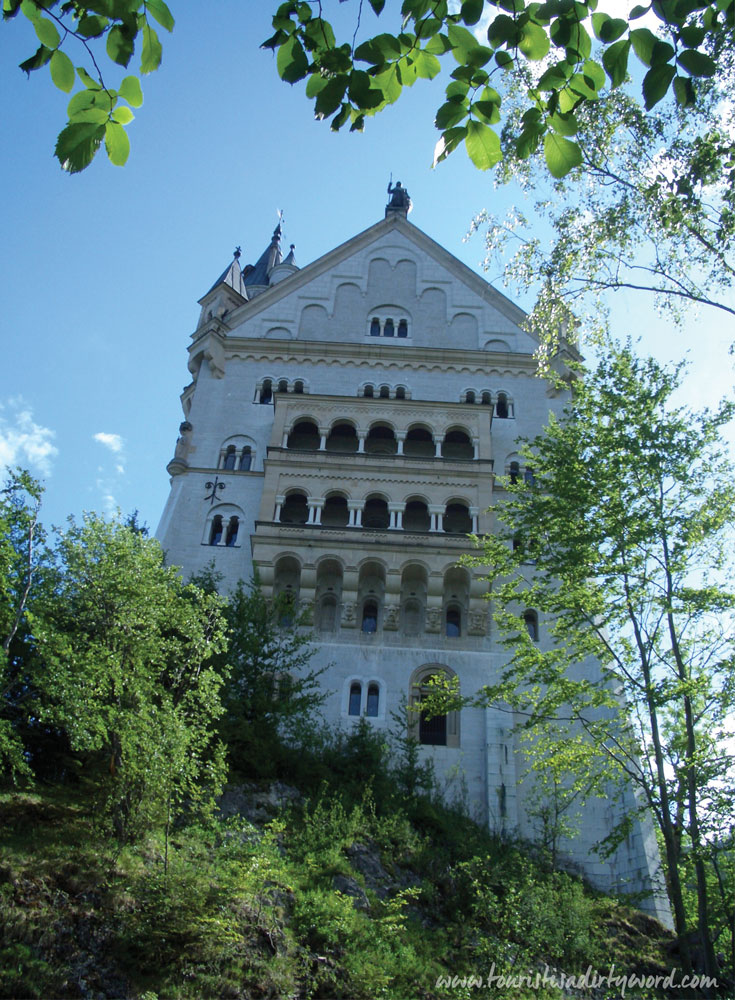
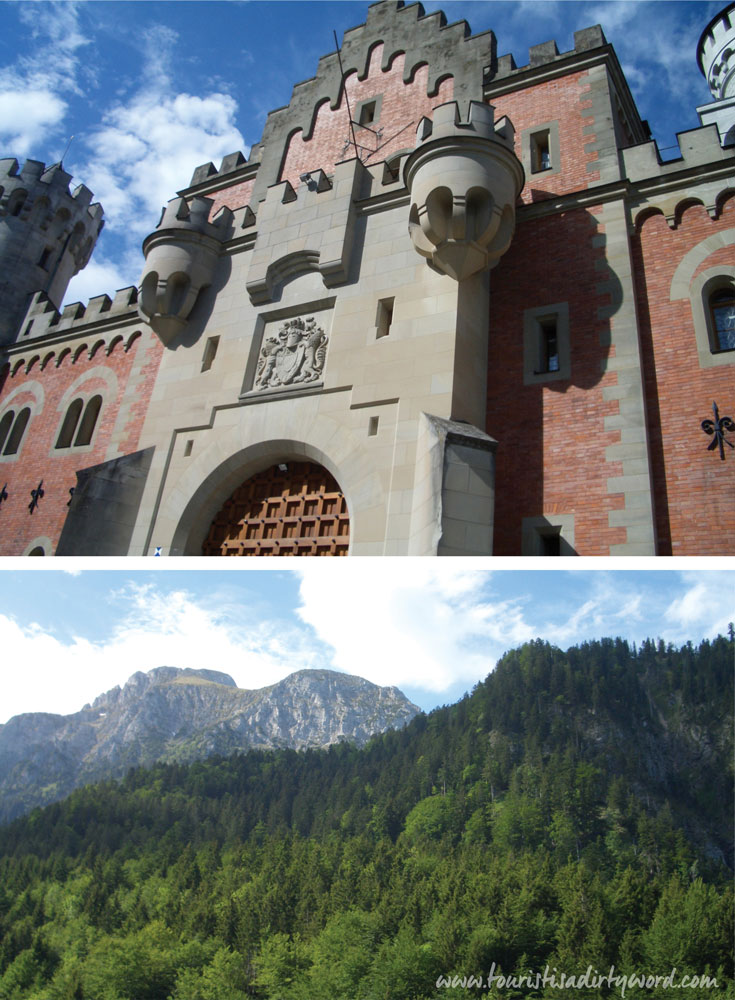
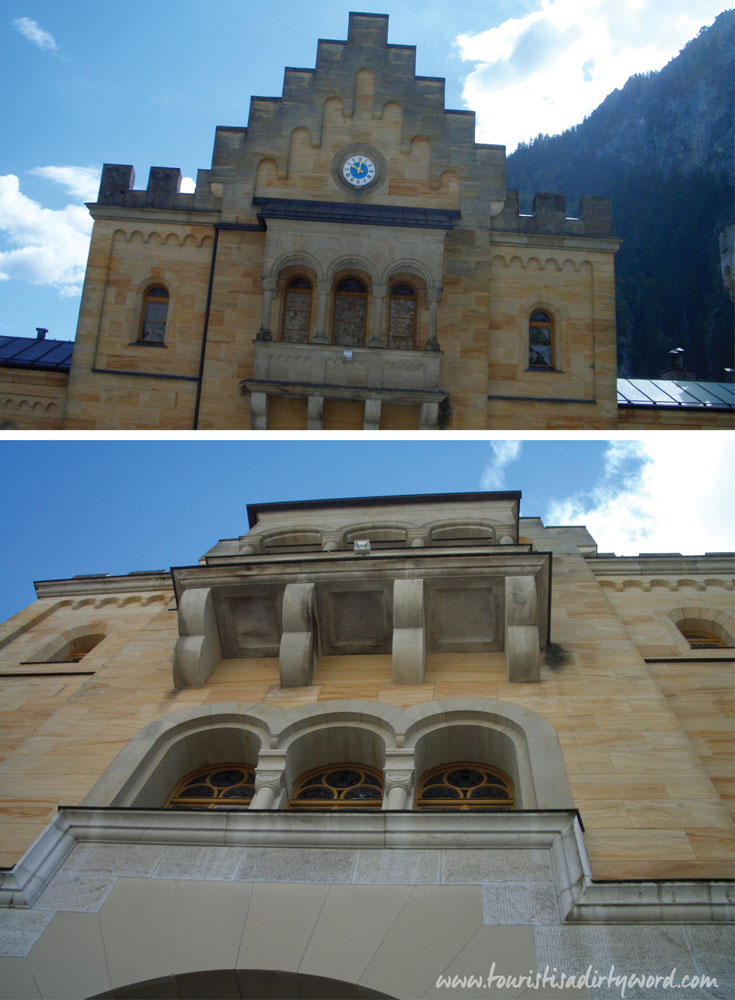
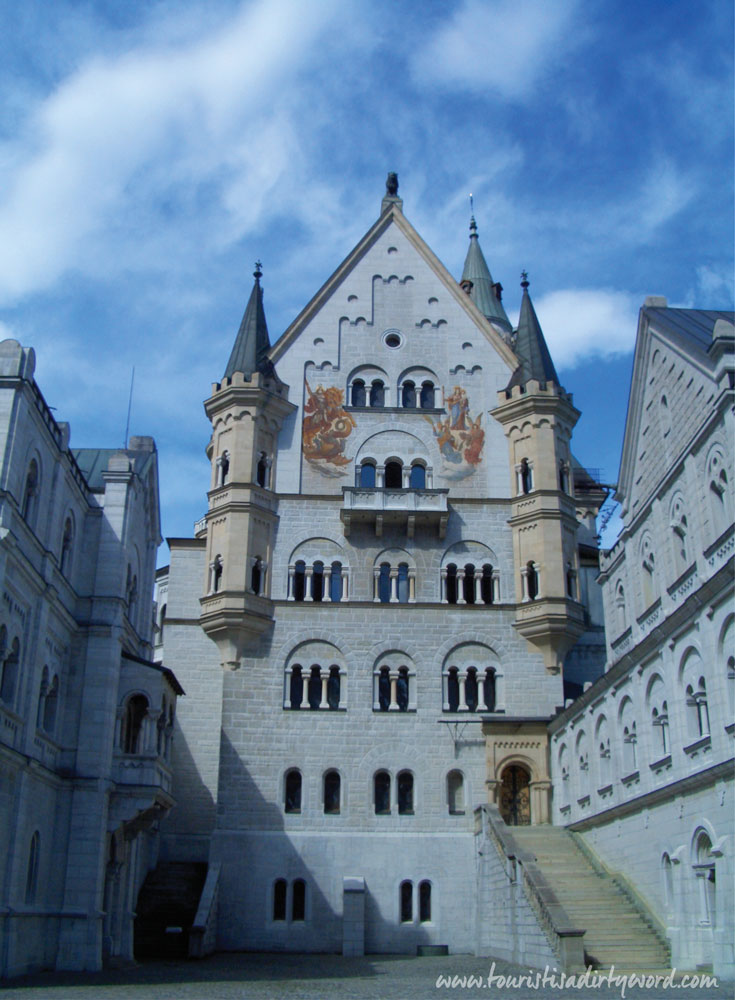
Our Guided Tour of Neuschwanstein
We met the guide who took us through the 14 finished rooms. The original plans for Neuschwanstein had more than 200 rooms planned, but Ludwig died before finishing them. The half hour tour went fast. The timing was down to the minute, and by the time we entered the next room, the group ahead was just leaving.
Early Bird Gets the Worm, or Opa is Usually Right
After the tour we walked down the hill again and as we got closer to the Welcome Center ticket counters, where Opa had no problem getting tickets earlier, we were amazed to see hundreds of people standing and waiting. More than a dozen buses had pulled up, unloading more people and at that moment I was very thankful that Opa made sure we arrived early and avoid as many crowds as we could.
So, is Neuschwanstein very touristy?
Yes, definitely. Easily the most touristy-experience I’ve ever had in Germany.
Should you skip it?
Definitely not, but go early and be prepared for crowds already in the late morning.
Neuschwanstein Castle Travel Tips
Here are 8 more tips and resources to help you plan your ideal visit to Neuschwanstein Castle:
1.You must buy your tickets in advance! Pick a date and time to visit and reserve tickets in advance here. That way you can skip the ticket purchase line and go directly to the will call counter, both located at the foot of the hill. Don’t go up to the castle expecting to buy a ticket there – you can’t. Tickets can be bought up until two days before. Tours run every 5 minutes and when you reserve your tickets online, you also reserve your tour language and tour time. Tours take about 30-35 minutes.
2. Check the weather and dress accordingly. You will be outside walking up and down a hill in order to get to the castle, so be prepared for lots of steps and some steeper trails. The walk takes about 20-40 minutes each way depending on your stride. Besides walking you can also take a horse drawn carriage or a bus. Both will be packed with people, so do not expect a romantic carriage ride up the hill with your loved one. You can not reserve the bus or carriage in advance. Also, neither the bus nor the carriage will take you all the way up to the entrance due to the tight space up there. Your walking time will be cut from 20-40 minutes to 10-15 by taking a bus or carriage.
3. If you arrive early, make sure to go onto the Marienbrücke before you go to the castle. Enjoy the grand view from there and catch your breath before going uphill again. The bridge will only get more and more crowded as the day goes on.
4. Bring small change for parking, restroom use, and or bus/carriage transportation up to the castle.
5. Backpacks, child carriers, and any bulky objects are not allowed to be taken onto the tour, and there are no lockers available at the castle. Leave them in the car or at your hotel.
6. No photography is allowed inside the Neuschwanstein castle. If you’re not passionate about photography, travel light: a decent mobile phone camera will suffice since you can only take outdoor photos anyway. You can see some of the rooms and a view from the Marienbrücke in this video from Rick Steves:
7. Here is an overview map of the Neuschwanstein Castle walking time estimates and bus/carriage pickup spots. Print this before you go and you’ll be a step ahead of the crowd.
8. Listen to this episode from Denise’s favorite podcast, Stuff You Missed in History Class which includes an explanation of Ludwig’s trap door dining table.
Follow Along
If you enjoyed this article, or these topics sound interesting to you, you'll love our weekly newsletter. You'll receive a free Germany Packing list for signing up, and you'll receive each week's newest posts every Friday. Thank you for reading!

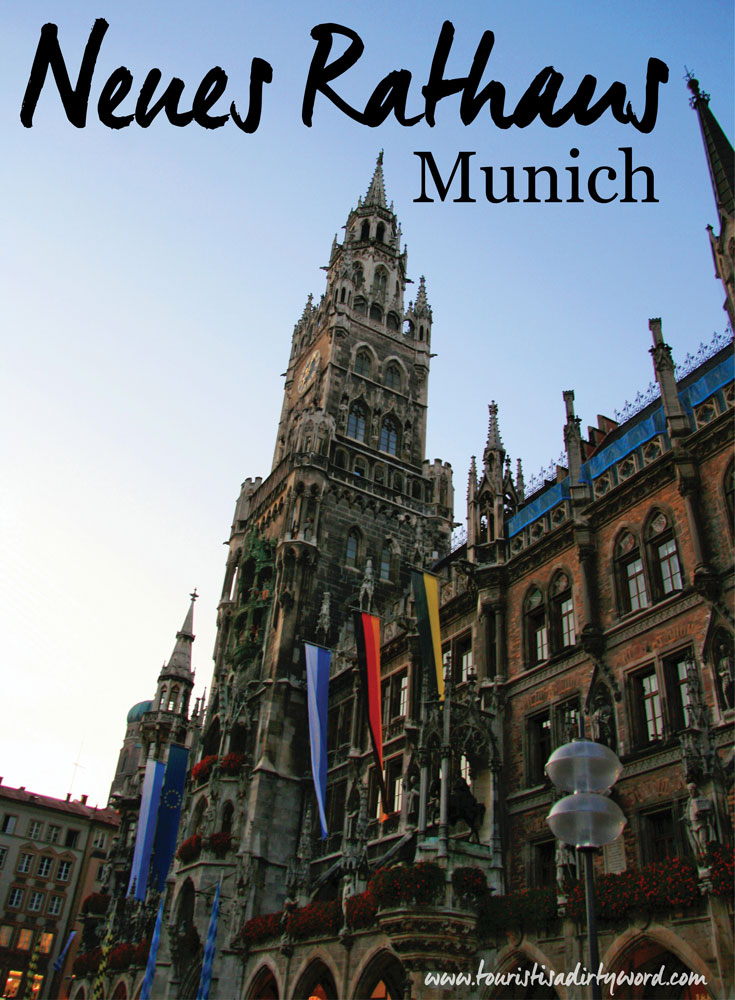
After a full day exploring Oktoberfest, we walked into the old part of Munich. Sensory overloaded from the beautiful costumes and wonderful food of the day, I waddled with my belly full of pretzels, chicken, and beer up this very pointy, church-looking building. The red flowers were shocking amongst the shadowy arcade of windows behind them. When I noticed all of the different flags on the side of the building, I realized it wasn’t a church.
It was the new town hall, Neues Rathaus, where the mayor and city council hold office, and the general headquarters of the Munich city administration. Briefly the memory of our own, gymnasium, institutional-looking city council building back home in Florida shimmers in my mind before dissolving into the beauty before me. It could have been all of the pretzels, but I was confused. Why was this the new town hall, and why did it look so old? And why did it look like a church?
Well, it's complicated, but I’m going to make it super simple..
First, a SUPER basic overview of European architecture (in chronological order) Romanesque to Gothic, to Renaissance, to Gothic Revival.
Romanesque, think sturdy and basic.
Easy way to remember it is the buildings look like sturdy, basic, buildings that could be recreated with preschool wooden building blocks. They got the job done, and didn’t get fancy. [6th century, thereabouts, to late 10th century]
Gothic architects looked at Romanesque buildings and thought, ‘meh, I can do better. Buildings don’t have to be boring.’
Gothic, think skeletal and busy.
Easy way to remember it is the builders wanted to go as high as possible, and let as much light in as possible.
Its easy to go taller if its pointy right? So Gothic has mostly pointy edges.
Want more light? Add more windows. LOTS of windows.
To make the building withstand all the weight now that it's so tall and has tons of windows, it needs more support, but no one wants to LOOK at enormous supporting columns. So they put them outside the building. That’s where the flying buttresses come swooping in to the rescue. Then they didn’t have facebook or instagram to distract them, so they decorated every inch of it. The buildings look visually busy. [12th century in France to 16th century]
Renaissance architects looked at Gothic buildings and thought, ‘Oh my goodness! My eyes are bleeding it’s so busy! Why recreate the wheel, the Greeks and Romans already figured out this stuff, we should just recreate that.’
Renaissance, think columns and geometric.
Easy way to remember it is renaissance sounds like reminisce, as in reminiscing about those old roman/greek glory days.
So here comes the primary school wooden building blocks again. I’ll give them this though, it is a bit more elegant, with a focus on symmetry, decorative columns, and oh-so-pleasing geometric shapes. They cheated a little and used gothic architecture engineering then covered up their tracks with thick, plain walls again. -15th century to 17th century-
Gothic Revival architects looked at Renaissance buildings, then Gothic buildings, then Renaissance buildings again...and thought 'We’re GERMAN. Not Romans, or Greeks! We’re German! We should have German buildings!' I have to mention that Gothic Architecture didn’t actually originate in Germany, it originated in France. Gothic wasn’t POPULAR in France any more! So the Germans thought this was solely their style.
Gothic or Gothic Revival?
The biggest difference between Gothic and Gothic Revival is time, 12th-15th century Gothic, 18th-20th century Gothic Revival. Beyond that, if the stone work looks more uneven, and there are obvious, huge, flying butresses, its likely Gothic. With new building techniques in the 18th-20th century the stones were much smoother and buttresses were not always necessary to support the building's weight.
You just learned how to identify four forms of architecture with a few minutes of reading! Hi-Five! For all my visual learners out there, I took some of my photos of the Munich Neues Rathaus and labeled it with visual clues that its gothic.

Back to the Neues Rathaus in Munich-
Why did the Neues Rathaus in Munich look so old?
Well, although it was built by Georg von Hauberrisser between 1867-1874, which isn’t all that long ago, the popular sentiment at the time believed life was better during medieval times, which had the gothic architecture. This building is part of the Gothic Revival period. They wanted to revive the self-governing glory days of the medieval times and Hanseatic League. It was a close call though. The Munich new town hall was almost Renaissance style. Click here for more about that, and I promise its brief too.
Why did the Neues Rathaus in Munich look like a church?
You know how when there’s a sequel to a movie, usually it's not as memorable as the first one? The first image that pops in my mind when you say Gothic is actually the Notre Dame cathedral in Paris, as well as many other churches. During the 12th and 16th century, when Gothic was born, they only had the time, energy, and motivation to go all out designing churches, and that’s what’s memorable. However, with gothic revival, just like the Neues Rathaus, they started applying that style of design to any type of building, civic buildings included.
Munich simply outgrew their Old Town Hall, which is still standing just around the corner. They even added additional annexes between 1899-1903. For the finishing touch, in 1908 they added a charming glockenspiel to the front facade.
Here are two glockenspiel videos from the Neues Rathaus in Munich, one is for day time, and the other is for night.
Other features worthy of note, there’s over 400 hundred rooms, you can go up to the 255-ft tall observation deck for a fantastic aerial view, and there’s a restaurant dating from 1867 in the basement.
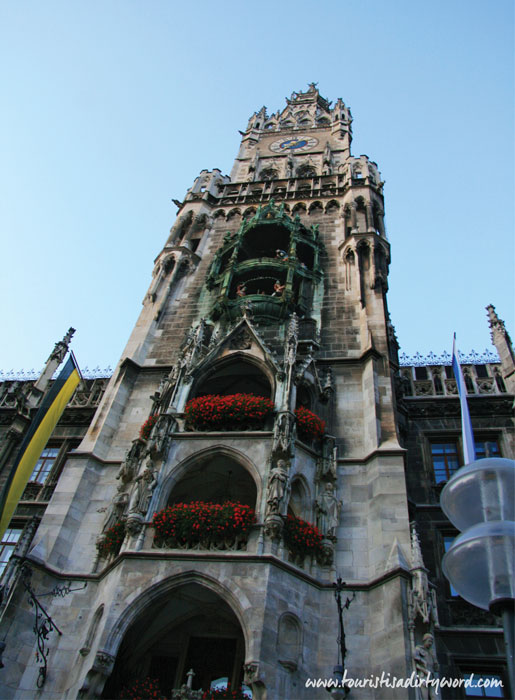
Follow Along
If you enjoyed this article, or these topics sound interesting to you, you'll love our weekly newsletter. You'll receive the newest posts each week and exclusive access to free planning resources like ‘Packing List & Tips for 2 Weeks in Germany’ and ‘Everything You Need to Rent a Car in Germany’.
Thank you for reading!

Bonus Resource: This book, The Gothic Revival by Michael J. Lewis was incredibly helpful in my research on this post about the Neues Rathaus. It's still available for sale on amazon (affiliate link). Chapter 3 was especially insightful on understanding Germany's perspective on the Gothic Revival.
Lewis, Michael J. The Gothic Revival. New York: Thames & Hudson, 2002. Print. Thames & Hudson World of Art.
